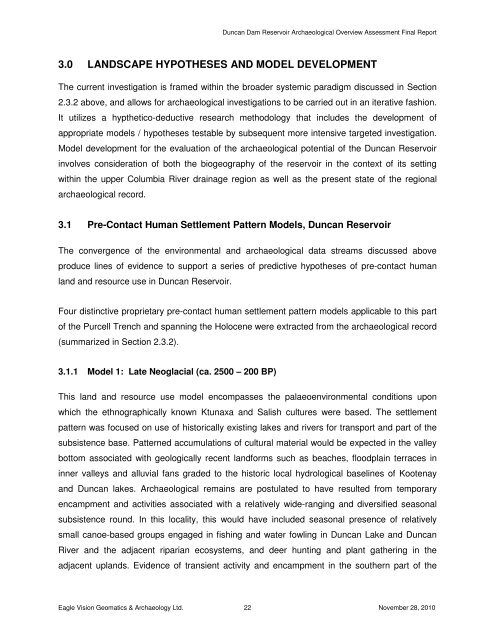November 2010 - BC Hydro
November 2010 - BC Hydro
November 2010 - BC Hydro
You also want an ePaper? Increase the reach of your titles
YUMPU automatically turns print PDFs into web optimized ePapers that Google loves.
Duncan Dam Reservoir Archaeological Overview Assessment Final Report<br />
3.0 LANDSCAPE HYPOTHESES AND MODEL DEVELOPMENT<br />
The current investigation is framed within the broader systemic paradigm discussed in Section<br />
2.3.2 above, and allows for archaeological investigations to be carried out in an iterative fashion.<br />
It utilizes a hypthetico-deductive research methodology that includes the development of<br />
appropriate models / hypotheses testable by subsequent more intensive targeted investigation.<br />
Model development for the evaluation of the archaeological potential of the Duncan Reservoir<br />
involves consideration of both the biogeography of the reservoir in the context of its setting<br />
within the upper Columbia River drainage region as well as the present state of the regional<br />
archaeological record.<br />
3.1 Pre-Contact Human Settlement Pattern Models, Duncan Reservoir<br />
The convergence of the environmental and archaeological data streams discussed above<br />
produce lines of evidence to support a series of predictive hypotheses of pre-contact human<br />
land and resource use in Duncan Reservoir.<br />
Four distinctive proprietary pre-contact human settlement pattern models applicable to this part<br />
of the Purcell Trench and spanning the Holocene were extracted from the archaeological record<br />
(summarized in Section 2.3.2).<br />
3.1.1 Model 1: Late Neoglacial (ca. 2500 – 200 BP)<br />
This land and resource use model encompasses the palaeoenvironmental conditions upon<br />
which the ethnographically known Ktunaxa and Salish cultures were based. The settlement<br />
pattern was focused on use of historically existing lakes and rivers for transport and part of the<br />
subsistence base. Patterned accumulations of cultural material would be expected in the valley<br />
bottom associated with geologically recent landforms such as beaches, floodplain terraces in<br />
inner valleys and alluvial fans graded to the historic local hydrological baselines of Kootenay<br />
and Duncan lakes. Archaeological remains are postulated to have resulted from temporary<br />
encampment and activities associated with a relatively wide-ranging and diversified seasonal<br />
subsistence round. In this locality, this would have included seasonal presence of relatively<br />
small canoe-based groups engaged in fishing and water fowling in Duncan Lake and Duncan<br />
River and the adjacent riparian ecosystems, and deer hunting and plant gathering in the<br />
adjacent uplands. Evidence of transient activity and encampment in the southern part of the<br />
Eagle Vision Geomatics & Archaeology Ltd. 22 <strong>November</strong> 28, <strong>2010</strong>

















